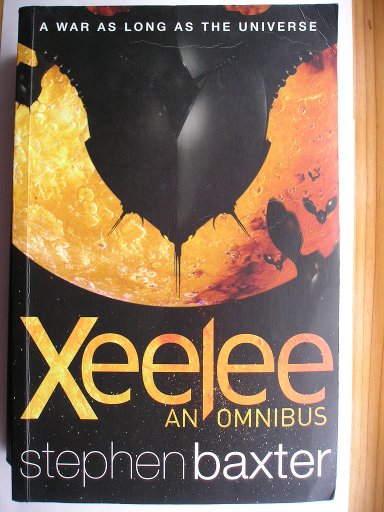
The novel “Timelike Infinity” by Stephen Baxter was published for the first time in 1992. It’s considered the second novel in the Xeelee Sequence.
In the 50th century, mankind is under the Qax dominion. A rebel group called the Friends of Wigner are able to build a spaceship that enters into one end of a wormhole created about fifteen centuries before by the famous scientist Michael Poole. The Friends of Wigner have a clear plan but they don’t intend to tell anyone before the right time has come.
When the Qax Governor realizes that the rebels managed to escape into the past, he decides to create another wormhole which has the other end five hundred years into the future. Thus he gets in touch with the future Qax and one of them emerges from the wormhole with the intention to exterminate humanity using technologies of the powerful and mysterious Xeelee.
“Raft” is considered the first novel in the Xeelee Sequence but only because it was the first written by Stephen Baxter and it’s loosely connected to the others. “Timelike Infinity” is actually the novel that lays the groundwork for this cycle and it’s also the first in which Xeelee are actually mentioned.
Since the beginning of his career, Stephen Baxter showed he was an author of hard science fiction writing stories in which scientific elements were crucial. “Timelike Infinity” contains a lot of speculation about possible scientific and technological developments of humanity but also possible aliens, starting with the Xeelee, and technologies used by them.
In “Timelike Infinity”, Stephen Baxter also addresses issues that are on the border between science and philosophy. In fact, the human rebels who call themselves Friends of Wigner base their plans on the paradox of Wigner’s friend. Baxter adds another layer of complexity to the novel because he doesn’t just introduce advanced science and technology but he leaves us until the end with the doubt about what’s the correct interpretation of the mind-body problem in quantum mechanics.
To arrive at that grand finale, Stephen Baxter begins “Timelike Infinity” with some subplots set in the era of scientist Michael Poole and in the era of the Qax domination. Throughout the novel, the subplots converge one after another to get the to the last part where the fate of humanity is decided.
The plan of the Friends of Wigner, who take advantage of the wormhole created by Michael Poole, involves a series of characters who have different plans for their future. However, the result isn’t an alliance of humans against Qax because among the members of the two species there are factions who have very different ideas on how to shape their future.
The story proceeds at a slow pace because it’s not a classic space opera in which there’s plenty of action. Instead, in “Timelike Infinity” there’s a lot of conversation between different characters and it’s also inevitable because that’s a good narrative device to let readers understand not only the science and technology of the future but also the intentions of the various characters.
The plot of “Timelike Infinity” is made more complex by the many scientific and technological elements important to the story. Stephen Baxter also finds the time to talk about the Ring, an immens Xeelee cosmic project. This is not just a digression, in fact it’s a way to lay the groundwork for his next novel “Ring”. The last chapter is also a link to “Ring”, in which the final part is repeated.
In “Timelike Infinity” the characters are discretely developed but without a particular depth. It’s a common feature of Stephen Baxter’s storie because he’s a writer more interested in developing scientific and technological ideas.
In my opinion, “Timelike Infinity” is an excellent basis for the stories of the Xeelee Sequence. This is a really complex novel that contains many scientific concepts and for this reason I recommend it especially to fans of hard science fiction.


Permalink
Permalink
Permalink